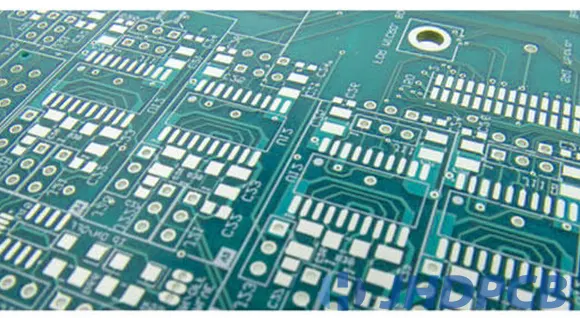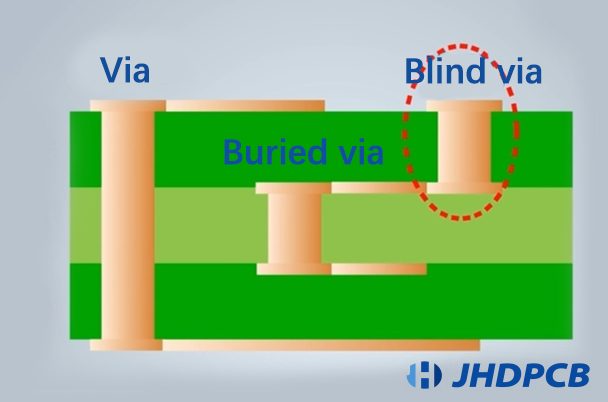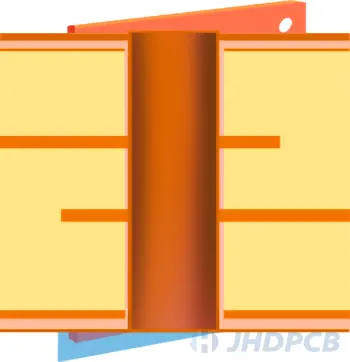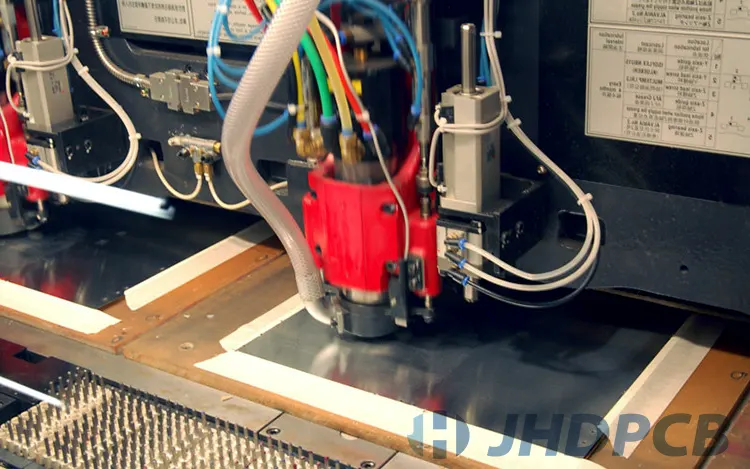PCB via plating
What is via plating in PCB?
PCB via hole plating has plenty of other names, such as PCB hole plating, PCB through hole plating(PTH), and PCB plating through holes. Through-hole technology, by means of inserting their leads through the corresponding holes to enable the components installed on the PCB boards. These holes are referred to as through holes, which were drilled from the top to the base of boards. The PCB hole plating process refers to that drilled holes being filled with copper in order to offer a current path within the whole inner hole. The current path can extend from one board surface to another or from the surface of the board to the inner layer of the board, and between two inner layers. Such a conductive mode can benefit in the electrical connection between copper tracks and components. In addition to this, it can also decrease the entire resistance to offer a stationary current flow and boost mechanical stability. For copper plating PCB vias, the PCB via plating thickness is at least 20µm.

Beyond that above, we have to know there are three common types of vias, including plated through-hole, buried hole, and blind hole. Then detailed information about these three vias will be offered to you.
Three common types of vias:
- Plating through holes-
Plating through holes is the most frequent via. The judgment criteria of being seen as a PTH is that you can see light when you raise up the PCB and face to the light. PTH has the simplest fabrication, it can be finished only by drilling a full hole or making a full hole through laser light. In addition to this, the cost of PTH is relatively inexpensive. But in some circumstances, plating through holes are not needed for some circuit layers. The reason is that PTH will take up more space even with cheaper costs. - Blind Via Hole(BVH)-
As its name suggested, blind via holes reveals that the opposite cannot be seen when the adjacent inner layer and the outermost circuit of the PCB are connected by a plated through-hole.
The main advantage of BVH is to improve the utilization rate of space for PCB circuit layer. But the depth of the hole is the most vital thing you should pay attention to. The z axis( the depth of the hole) should be suitable. This production method can merely be used because of the difficulty of hole plating. - Buried Via Hole (BVH)-
Buried via holes can connect the PCB’s any circuit layers except the outermost layer. This process must be finished in a complex way. The first step is you need to carry out the internal bonding after the plating treatment when other individual circuit layers are drilled. Then the all is bonded. The cost of Buried via holes is the most expensive because of its longer fabrication time than blind via holes and through holes. This product method can be employed in HDI (high-density) circuit boards in order to add more available space for other circuit layers.
Click to view more detailed PCB hole type information.

The reason for PTHs failure.
The plated through-holes fail as a consequence of cracks in the hole’s copper plating, which can also be referred to as barrel fatigue. Then the reason for the cracks in the copper plating is the different values between the copper plating(17 ppm) and PCB boards(70 ppm). Appropriate diameter, plating thickness, and materials, architecture, and material CTE are required for a durable and reliable PTH. The proper height of architecture is from 30 to 250 mil. For diameter, it’s from 30 to 250 mil. Inadequate plating thickness can arise from inadequate time or current in the copper plating bath.
How to plated pcb via holes?
In order to give you a clear understanding of via plating, the following will be divided into four parts to explain in detail:
- PCB hole plating process flow;
- The capability of hole plating;
- Stakes of hole plating;
- Three PTH thicknesses;
In the manufacturing process, the plating course of vias and the rest of the circuit board will be completed together. For micro vias, the fabrication process will differ, because they have the feature of being on different layers and laser drilled. And for blind vias and buried vias, there exist varied processes. Detailed PCB microtia, blind via and buried via process can be learned on our corresponding pages. But for standard via plating, the fabrication process can be as follows:
PCB hole plating process flow.
- After the various board layers are laminated together according to the PCB design requirements. Various types of vias can be drilled, including vias, non-plated holes, and component pin holes.
- For the purpose of clearing away debris from resin residue inside the hole to burrs on the edge of the holes, the drilling operation binds to the chemical process and abrasive mechanical process.
- In order to offer copper plating as the basis of implementation, the surface of the board and holes will be added to a thin layer of copper coating in a chemical way.
- The exposed metal areas of the boards and via holes are plated with all copper. This step can be finished by a way of connecting an electrical charge with the board, which aims to achieve the goal of the board serving as cathodes in the PCB via a plating process. The next step is to put boards into chemical baths. Multiple bathes for plating and cleaning are required for boards, and the whole process experiences tight and strict control to ensure that an even magnitude of copper is produced. In order to accomplish evenly copper plating inside via holes, the plating process and chemical solutions are all designed to a new version that owns a good “throwing power”.
- The result of tin being plated on top of this and serving as an etch resist can be created, after when the surface of the board and the holes are plated by copper.
- In the end, any copper areas, not being protected by tin, are etched. The leaving parts only include area fills, desired traces, and plating inside the via holes.
Capability of hole plating.
The capability of using both sides of the printed circuit board and connecting to other layers of the board can be fulfilled by plating through holes. Copper can act as conductor and the plating coating on the through holes is copper too. So plated through holes can support electricity passing through circuit boards, To improve electrical performance, it is helpful for high-frequency design. Also helps to dissipate heat.
Stakes of hole plating.
As a result, you totally need to use printed circuit boards with plated through holes, if you are expected to have a high-efficiency electronic product. But, to be honest, there certainly exists some risks.
The problem of thermal cycling will impact all products with printed circuit boards. They will consistently heat up when we charge them up. This condition will last until they are cut down, which is the time to cool down. The temperature will increase together with the temperature rising of the product. The risk of cracking will ascend as the repeated process of heating up and cooling down. The PCB hole plating thickness of copper plating determines the time of thermal cycling. Namely, the thicker the copper is, the longer it can persist. The service life of the printed circuit board is inextricably bound up with the thickness of copper plating inside the through hole because the failure of boards is directly resulted by this cracking.

Three PTH thicknesses.
There are three types of thicknesses when it comes to plated through holes. You will be given a brief introduction as table below:
| Classification | Features | Application |
|---|---|---|
| IPC Class 1 | Shortest service life; Thin; | Consumer electronics: out of date in few years |
| IPC Class 2 | Longer service life; Having continuously used holes; | Copy machines and computers: can be used for five or more years |
| IPC Class 3 | The thickest among all classes; Longest service life of plated through holes; | Products expected to last ten or more years |
Click here to learn more about IPC standards in the PCB industry.
JHD Via Plating Tolerances.
It’s super normal that PCB tolerances are ubiquitous in various parts of PCB manufacture. For PCB tolerance, IPC6012C and IPC600H all have stipulated acceptance standards of three classes. This means that different PCB tolerances are required by different classes. Beyond that, the class 3 PCB has the most strict plating tolerance. Customers should select the most suitable acceptance criteria, and Class 2 is enough for most products. As a result, JHD will test and inspect our PCB productions according to IPC600H Class 2( or Class 3) and IPC6012C Class 2(or Class 3). Click to view JHD’s test system.
It’s a better choice to consider tolerance before design, which contributes to the manufacture and application of PCB products.
Drilling tolerance
It’ ‘s needed for standard plated through holes that the finished hole size is smaller about 0.006” than the drilled hole size. This can facilitate copper from 0.0008” to 0.001” to be plated inside the hole.
The drilling tolerance can be caused by two reasons. The first one is the long-term used drill bit is not as sharp as a new drill bit and the size of the old drill bit is no longer a standard size. Some cases may occur when one of the three stacked panels shifts a little, including the not nominal drill size, the drill misregistration, and the process of the head moving up and down.

Routing tolerance
The tolerance of routing has a greater tolerance than the drilling process. The routing tolerance is caused by the tolerance of the router bit itself and the track deviation of router bits.
If a 0.250” finished plated hole is needed by a PCB circuit board, a 0.256” diameter opening is required to be created by the router for plated holes. For the 0.256” diameter opening, the tolerance of itself is +/-0.004. under this circumstance, it’s the perfect status for the finished 0.250” size that the tolerance is +/-0.005. Beyond that, the process has two variables, one is chemistry, the other one is the faster plating speed of smaller holes than bigger holes in most cases.
Chemical Plating tolerance
As the copper plating process, the size of the hole will lessen and then equal to the finished size. It’s impossible for the current technology to realize a +/-0.001” tolerance. The +/-0.003” tolerance is the most suitable choice for holes with sizes up to 0.249”.
The process of copper plating is determined by three factors, including the amps of current sent into circuit boards, the temperature of the tanks, and the time of circuit boards in the plating tanks. For a standard plating process, it requires 45 minutes to an hour to plate enough copper inside the hole. The size of the plating hole tolerance is caused by time in the plating tanks, the amps involved, the chemistry variables, and the temperature of the tanks. Affected by these factors, the size tolerance of finished plated holes is +/-0.003”.
For press fit holes, in order to achieve a tight fit between components and the hole, the perfect tolerance of them is +/-0.002”, which is the strict tolerance required by the plating department. IPC 0.0007 mils are the first choice for holes under this tolerance. And in this way, those press-fit holes can be easily plated within +/-0.002” tolerance. And all the +/-0.003” holes will be within the tolerance. Because of the required longer time of panels staying in plating tanks, it’s harder to achieve the plating tolerance is within +/-0.002”, when a 0.001” minimum size is required by customers.
Slots And Cutouts tolerance
A big plating nightmare will be caused by a drill chart that requires a tolerance is +/-0.003” for plated holes and have big cutout plated ares and slots with a tolerance of only +/-0.003”. The large plated cutouts are at the upper end of the tolerance under the condition of +/-0.002” holes being plated to the finished required size of +/-0.002”. As a result, all the cutouts and holes can be nominal finished sizes when the holes tolerances are +/-0.003” and the slots and cutouts tolerances are +/-0.005”.
Choose JHD to escort your PCB edge plating& PCB hole electroplating.
JHD has rich fabrication experience of full range a PCB products and was founded in 2009.
Reliable quality and advanced facilities
Advanced facilities and reliable quality are the purposes of customer service. We own the most advanced testing and fabrication equipment and have gained wide acceptance from our customers and Industry peers. In addition to this, we have gotten a battery of industry certifications to make sure the quality and safety of PCB products in our company, including ISO 14001, UL, ISO 9001, RoHS, IPC Class 2/3, etc.
Prominent manufacturing capacity and Professional team
What we achieve today is closely related to our excellent and professional team. We have a professional R&D team of more than 150 and a top-edge production team of more than 400.
Lower price and quick delivery
Since 2009, we pursue the objective of achieving a decrease in costs and an increase in production efficiency. We have achieved the cheering result that the procurement costs can be reduced by at least 30% by mass production, low labor costs, and high production efficiency.
In order to deliver the goods quickly, we have an adequate inventory of raw materials, reliable logistics partners, a full-chain digital order management system and12 hours fast response sales team.





